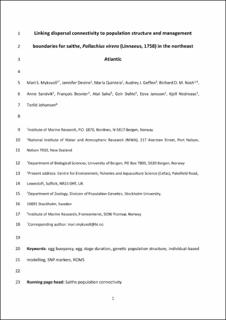| dc.description.abstract | Population connectivity is an increasingly important focal area for the understanding of how marine fish populations respond to anthropogenic pressures like climate change and fisheries. Our model species, the saithe Pollachius virens (Linnaeus, 1758), was chosen because genetic analyses have documented a mismatch between the assessed stocks and the biological populations. We combined laboratory experiments of saithe egg buoyancy and temperature-modulated development time, genetic field data, and high-resolution oceanographic models to disentangle the mechanisms causing isolation and mixing between the management units and the biological populations. Saithe egg buoyancy and development data were included in an individual-based model to simulate transport from all known spawning grounds in the Northeast Atlantic. The results show that interannual variability in the transport of early life stages is strongly influenced by wider climate systems (e.g. the North Atlantic Oscillation). One sample (Rockall) showed genetic differences from the other samples, and this finding was supported by the model showing low mixing with other populations and strong local retention. Strong retention of early life stages around Iceland could indicate an isolated population; however, this possible isolation is counteracted by active migration of adults westward from the Norwegian coast, and no genetic differentiation from other populations was found. Overall, the dispersal modeling supports the genetic analysis, showing a large and well-connected Central Northeast Atlantic population distributed across several management units. This mismatch between population structure and management units can potentially increase the risk for overexploitation of saithe. | en_US |
